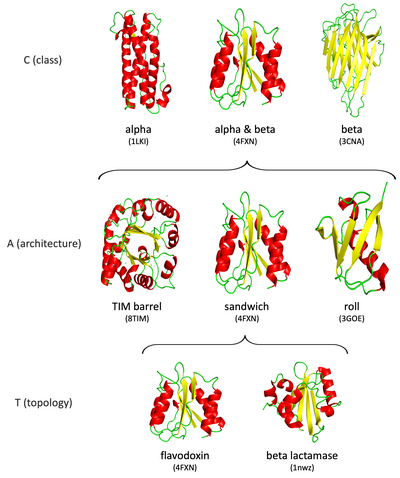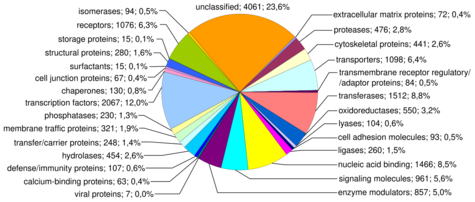Biology:List of proteins

Proteins are a class of macromolecular organic compounds that are essential to life. They consist of a long polypeptide chain that usually adopts a single stable three-dimensional structure. They fulfill a wide variety of functions including providing structural stability to cells, catalyze chemical reactions that produce or store energy or synthesize other biomolecules including nucleic acids and proteins, transport essential nutrients, or serve other roles such as signal transduction. They are selectively transported to various compartments of the cell or in some cases, secreted from the cell.
This list aims to organize information on how proteins are most often classified: by structure, by function, or by location.
Structure
Proteins may be classified as to their three-dimensional structure (also known a protein fold). The two most widely used classification schemes are:[2]
Both classification schemes are based on a hierarchy of fold types. At the top level are all alpha proteins (domains consisting of alpha helices), all beta proteins (domains consisting of beta sheets), and mixed alpha helix/beta sheet proteins.
While most proteins adopt a single stable fold, a few proteins can rapidly interconvert between one or more folds. These are referred to as metamorphic proteins.[5] Finally other proteins appear not to adopt any stable conformation and are referred to as intrinsically disordered.[6]
Proteins frequently contain two or more domains, each have a different fold separated by intrinsically disordered regions. These are referred to as multi-domain proteins.
Function

Proteins may also be classified based on their celluar function. A widely used classification is PANTHER (protein analysis through evolutionary relationships) classification system.[7]
Structural
Catalytic
Enzymes classified according to their Enzyme Commission number (EC). Note that strictly speaking, an EC number corresponds to the reaction the enzyme catalyzes, not the protein per se. However each EC number has been mapped to one or more specific proteins.
- List of enzymes
- EC 1: Oxidoreductases
- EC 2: Transferases
- EC 3: Hydrolases
- EC 4: Lyases
- EC 5: Isomerases
- EC 6: Ligases
- EC 7: Translocases
Transport
Immune
- Antibody
- Chemokines and their receptors
- Cytokines and their receptors
- Pattern recognition receptors
Genetic
- DNA/RNA synthesis
- DNA repair
- replication
- transcription (Transcription factor, transcriptional coregulator)
Signal transduction
Sub-cellular distribution

Proteins may also be classified by which subcellular compartment they are found.[9][10]
Nuclear
Cytosolic
Cytosolic proteins
Cytoskeletal
Cytoskeletal proteins
Organelle
Endoplasmic reticulum
Endoplasmic reticulum resident protein
Lysosomal
Mitochondial
Mitochondrial DNA that encode mitochondial proteins (note that some mitochondial proteins are encoded by nuclear DNA)
Chloroplast
Chloroplast DNA that encode chloroplast proteins
Cell membrane
Extracellular matrix
Extracellular matrix proteins
Plasma
Species distribution
- Mammalian
- Vertebrate
- Plant
- Bacterial proteins
- Archaeal proteins
- Viral proteins
References
- ↑ "CATH--a hierarchic classification of protein domain structures". Structure (London, England) 5 (8): 1093–108. August 1997. doi:10.1016/s0969-2126(97)00260-8. PMID 9309224.
- ↑ "Systematic comparison of SCOP and CATH: a new gold standard for protein structure analysis". BMC Structural Biology 9: 23. April 2009. doi:10.1186/1472-6807-9-23. PMID 19374763.
- ↑ "CATH: increased structural coverage of functional space". Nucleic Acids Research 49 (D1): D266–D273. January 2021. doi:10.1093/nar/gkaa1079. PMID 33237325.
- ↑ "SCOP2 prototype: a new approach to protein structure mining". Nucleic Acids Research 42 (Database issue): D310–4. January 2014. doi:10.1093/nar/gkt1242. PMID 24293656.
- ↑ "Design and discovery of metamorphic proteins". Current Opinion in Structural Biology 74: 102380. June 2022. doi:10.1016/j.sbi.2022.102380. PMID 35561475.
- ↑ "Intrinsically Disordered Proteins: An Overview". International Journal of Molecular Sciences 23 (22): 14050. November 2022. doi:10.3390/ijms232214050. PMID 36430530.
- ↑ 7.0 7.1 "PANTHER: a browsable database of gene products organized by biological function, using curated protein family and subfamily classification". Nucleic Acids Research 31 (1): 334–341. January 2003. doi:10.1093/nar/gkg115. PMID 12520017.
- ↑ "Hum-mPLoc 3.0: prediction enhancement of human protein subcellular localization through modeling the hidden correlations of gene ontology and functional domain features". Bioinformatics 33 (6): 843–853. March 2017. doi:10.1093/bioinformatics/btw723. PMID 27993784.
- ↑ Trans J (2014). "Subcellular Compartments" (in en). Scitable. Nature Education. https://www.nature.com/scitable/topic/subcellular-compartments-14122679/.
- ↑ "A subcellular map of the human proteome". Science 356 (6340). May 2017. doi:10.1126/science.aal3321. PMID 28495876.
 |

